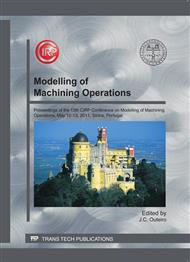[1]
Shaw M.C., Vyas A. Heat-Affected Zones in Grinding Steel, Annals of CIRP, Vol. 43(1) (1994) pp.279-282.
DOI: 10.1016/s0007-8506(07)62213-6
Google Scholar
[2]
Umbrello D., Filice L. Improving Surface Integrity in Orthogonal Machining of Hardened AISI 52100 Steel by Modeling White and Dark Layers Formation, Annals of CIRP, Vol. 58(1) (2009) pp.73-76.
DOI: 10.1016/j.cirp.2009.03.106
Google Scholar
[3]
Busso P., A continuum theory for dynamic recrystallization with microstructure related length scales, International Journal of Plasticity, Vol. 14, Nos 4-5 (1998), pp.319-353.
DOI: 10.1016/s0749-6419(98)00008-4
Google Scholar
[4]
Chen L., Wang Y., The continuum field approach to modeling microstructure evolution, JOM; Vol. 48, 12 (1996), ABI/INFORM Trade & Industry, pg. 13.
Google Scholar
[5]
Doherty R.D., Hughes D.A., Humphreys F.J., Jonas J.J., Juul Jensen D., Kassner M.E., King W.E., McNelley T.R., McQueen H.J., Rollett A.D., Current issues in recrystallization: a review, Materials Science and Engineering A238 (1997) 219–274.
DOI: 10.1016/s0921-5093(97)00424-3
Google Scholar
[6]
Glowacki M., Kuziak R., Malinowski Z. and Pietrzyk M., Modelling of heat transfer, plastic flow and microstructural evolution during shape rolling, Journal of Materials Processing Technology Vol. 53 (1995) pp.159-166.
DOI: 10.1016/0924-0136(95)01972-h
Google Scholar
[7]
Qu J., Jin Q.L., Xu B.Y., Parameter identi-fication for improved viscoplastic model considering dynamic recrystallization, International Journal of Plasticity 21 (2005) 1267–1302.
DOI: 10.1016/j.ijplas.2004.04.009
Google Scholar
[8]
Sellars C.M., Zhu Q., Microstructural modeling of aluminium alloys during ther-momechanical processing, Materials Science and Engineering Vol. A280 (2000) p.1–7.
Google Scholar
[9]
Swaminathan S., Ravi Shankar M., Lee S., Hwang J., King A. H., Kezar R. F., Raoa B. C., Browna T. L., Chandrasekar S., Dale Compton W., Trumble K. P., Large strain deformation and ultra-fine grained materials by machining, Materials Science and Engineering Vol. A 410–411 (2005).
DOI: 10.1016/j.msea.2005.08.139
Google Scholar
[10]
G. Poulachon, A. Albert, M. Schluraff, I.S. Jawahir, An experimental investigation of work material microstructure effects on white layer formation in PCBN hard turn-ing, International Journal of Machine Tools & Manufacture Vol. 45 (2005).
DOI: 10.1016/j.ijmachtools.2004.07.009
Google Scholar
[11]
Ramesh A., Melkote S.N., Analysis of white layers formed in hard turning of AISI 52100 steel, Materials Science and Engineering Vol. A390 (2005) p.88–97.
DOI: 10.1016/j.msea.2004.08.052
Google Scholar
[12]
Tomlinson W.J., Blunt L.A., Spraggett S. White Layers on Surface of Ground EN24 Steel. 1. Microstructure, Composition, Internal Stress, and Corrosion Properties, Surface Engineering, Vol. 5(3) (1989) pp.229-233.
DOI: 10.1179/sur.1989.5.3.229
Google Scholar
[13]
Umbrello, D. 2010, Influence of Material Microstructure Changes on Surface Integ-rity in Hard Machining of AISI 52100 Steel, in press on Int. J. Adv. Manuf. Technol., (DOI: 10. 1007/s00170-010-3003-x).
DOI: 10.1007/s00170-010-3003-x
Google Scholar
[14]
Yanagimoto J., Karhausen K., Incremental Formulation for the Prediction of Flow Stress and Microstructural Change in Hot Forming, Journal of manufacturing science and engineering, Vol. 120 2 (1998).
DOI: 10.1115/1.2830129
Google Scholar


